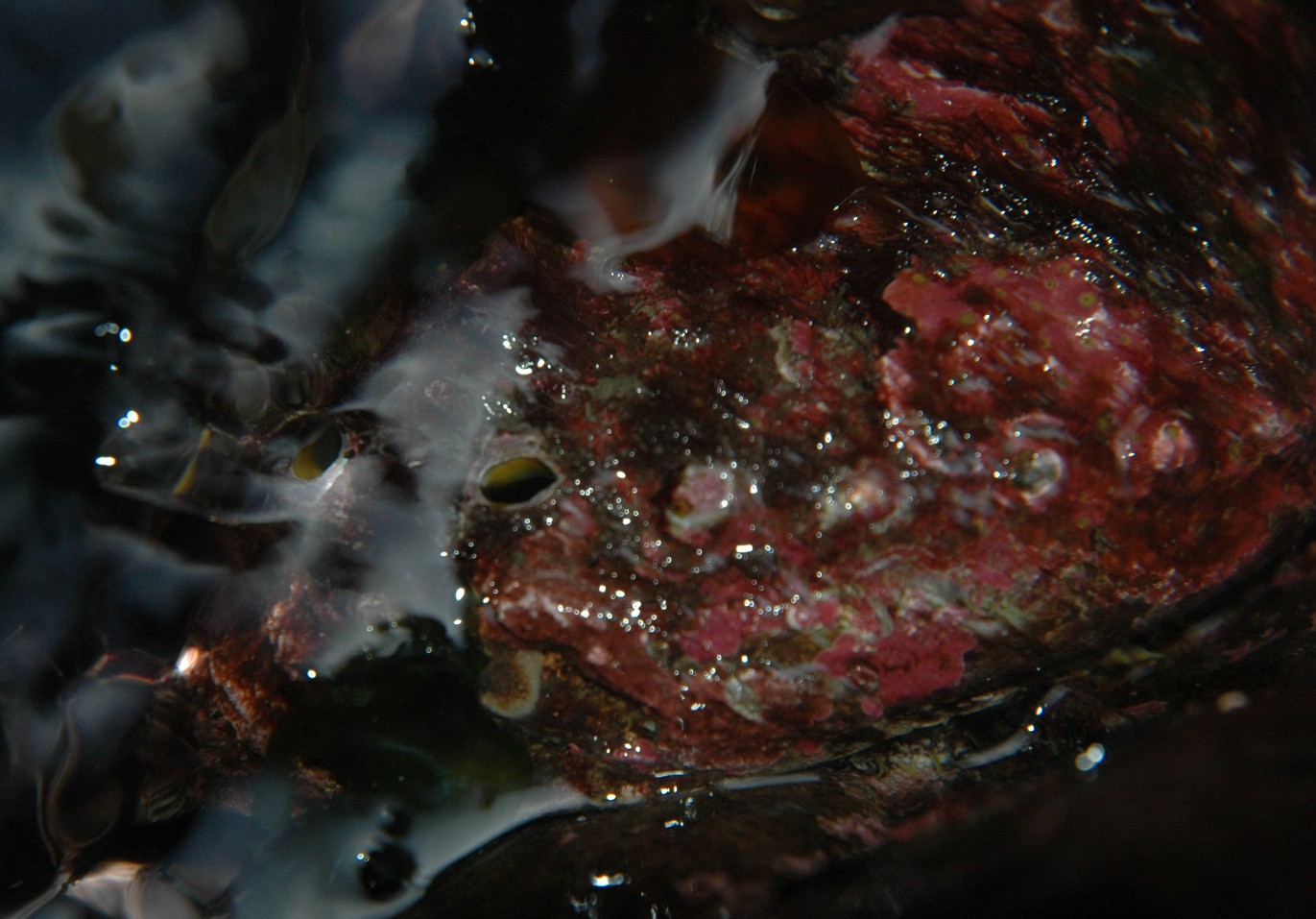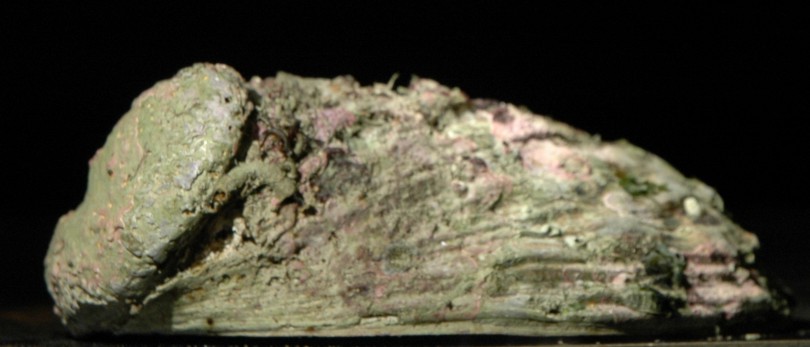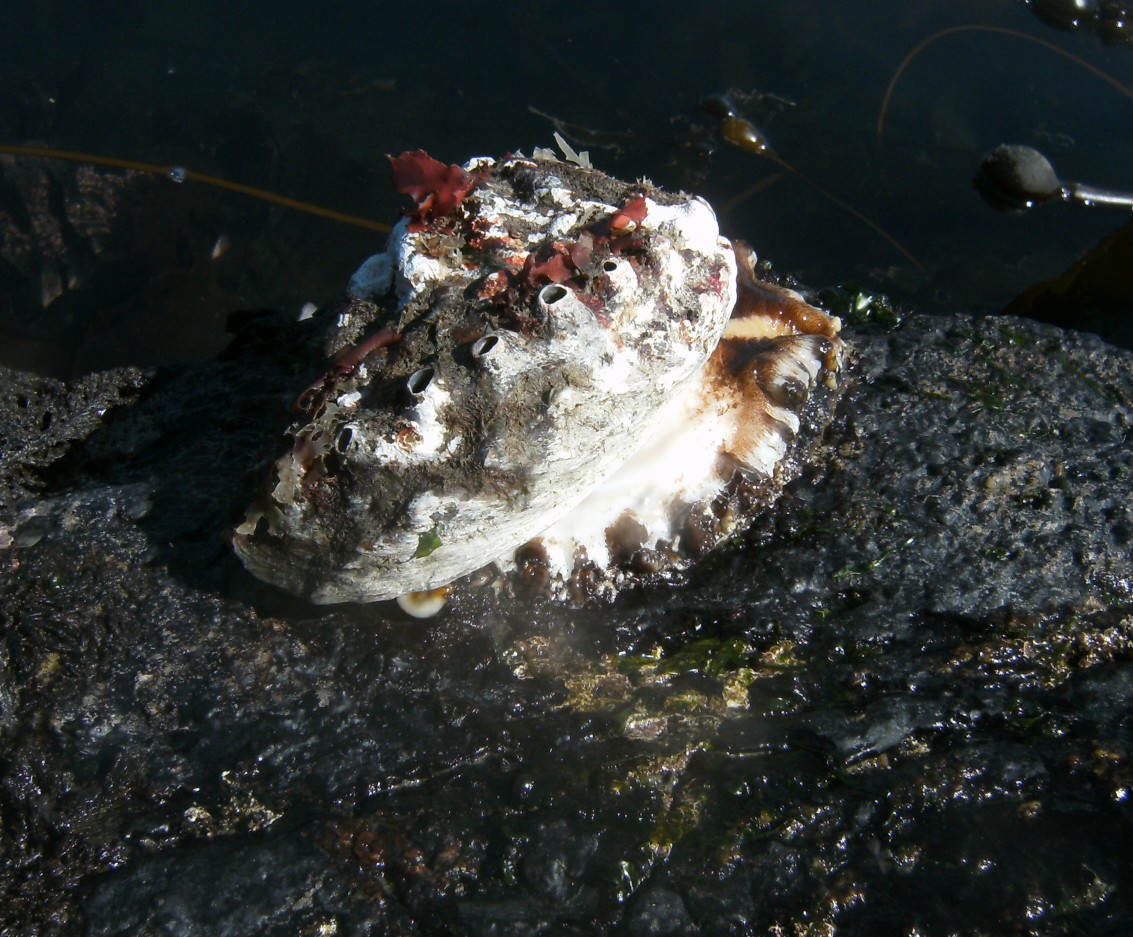Haliotis kamtschatkana Jonas, 1845Common name(s): Pinto abalone, Small northern abalone, Northern abalone, Alaskan abalone, Kamchatka abalone, Japanese abalone |
|
| Synonyms: H. kamschatkensis |  |
| Phylum Mollusca
Class Gastropoda Subclass Prosobranchia Order Archaegastropoda Suborder Pleurotomariina Family Haliotidae |
|
| Haliotis kamtschatkana clings to a rock at low tide near Rosario (undisclosed location). Total length is approximately 14 cm. Note the bright yellow bottom of the foot and the black markings on the side of the foot and the mantle. | |
| (Photo by: Dave Cowles, July 2006) | |
How to Distinguish from Similar Species: Other abalone species are not likely to be found this far north. H. cracherodii has a smooth exterior. H. walallensis has a shell with low spiral ridges and has pale green, blue, or white mottling. H. rufescens has a thicker shell with a prominent muscle scar and grows much larger (to 30 cm). None of these other abalone species has as prominent a spire.
Geographical Range: Aleutian Islands, Alaska to Point Conception, California; northern Japan, Siberia. This is the most northerly occurring species of abalone.
Depth Range: Low intertidal to 15 m; more common subtidally
Habitat: On hard substrates, usually subtidal (especially in the southern part of its range), and is most common on the outer coast. In places where this species is common, it is said to sometimes occur in large aggregations.
Biology/Natural History: Abalones such as this one are herbivores, grazing on algae. They eat many species (including coralline algae) but prefer Nereocystis luetkeana (bull kelp) and seersucker kelp (Costaria costata). This species also eats benthic diatoms. Pedal waves of contraction on the foot of this species are direct (back to front), and portions of the foot are lifted from the substrate during the wave. Predators include Enteroctopus dofleini, and sea and river otters. When touched by a predatory seastar such as Pycnopodia helianthoides or Leptasterias hexactis, this species exhibits a marked escape reaction. It rises up, twists violently to swivel the shell from side to side, and crawls rapidly away with its tentacles waving. It can crawl up to 15 shell lengths per minute. May contain the symbiotic scaleworm Arctonoe vittata. Spawning is probably late spring to summer, with up to 2.3 million green eggs released per female. Their swimming veliger larvae are attracted by coralline algae and settle there. In British Columbia, takes about 2 yrs to grow to 3.5 cm and 5-6 years to grow to 7.5 cm. In Alaska, become sexually mature at about 6.5 cm. Sometimes hybridizes with Haliotis rufescens. The shell of this species is too thin for the animal to be fished much commercially, though some is done.
| Return to: | |||
| Main Page | Alphabetic Index | Systematic Index | Glossary |
References:
Dichotomous Keys:Flora and Fairbanks, 1966
Griffith, 1967
Kozloff 1987, 1996
Smith and Carlton, 1975
General References:
Carefoot,
1977
Gotshall,
1994
Harbo,
1997
Harbo,
1999
Kozloff,
1993
McConnaughey
and McConnaughey, 1985
Morris,
1966
Niesen,
1997
O'Clair
and O'Clair, 1998
Ricketts
et al., 1985
Sept,
1999
Scientific Articles:
Web sites:
General Notes and Observations: Locations, abundances, unusual behaviors:
Unfortunately for this species, abalones are thought to be very tasty. While abalones were at one time fairly abundant along the US Pacific coast, in most places they have been hunted down to very low numbers. In many summers of teaching and exploring in the area around Rosario I have rarely seen ones intertidally such as those shown here, though occasionally one is encountered subtidally or an old, barnacle-ridden shell is found. It is said that abalones are not efficient at reproduction unless they are within about a meter of each other. If that is so, then the prospects for this species' continued survival in the Rosario area is grim because rarely are they found that close together. My advice is: If you encounter an abalone in the Puget Sound area, either above or below water, LEAVE IT ALONE--it is likely one of only a very few survivors in the area and might be critical for the species' survival here. Do not try to disturb it--it hangs extremely tightly onto the rock and, with the thinner, more brittle shell that this species has compared to other abalones, even trying to move it may cause irreparable damage to the shell. Also, they bleed very easily so slipping a knife or other object under the foot to force it to release may cause serious damage or death.

Another individual crawls along a rock at water's edge at an
undisclosed
location near Rosario.
This individual is 13 cm long, 9 cm wide, and 4 cm high and has 4 open
holes. The anterior end of the animal is to
the left. Two of the open holes are visible on the left and a
string of older, more posterior filled holes can be seen to the right.
Note that the holes are oval and slightly elevated. The pink
coloration is coralline algae.

This species has a higher profile and a more pronounced spire (to the
left) than most other abalone species, as can be seen in this view from
the right side. Posterior is to the left.

This photo of a young Haliotis kamtschatica recruit
is by Aaron
Baldwin
This individual is crawling along an unnamed rock in the Rosario area at low tide, 2012.
Authors and Editors of Page:
Dave Cowles (2006): Created original page
